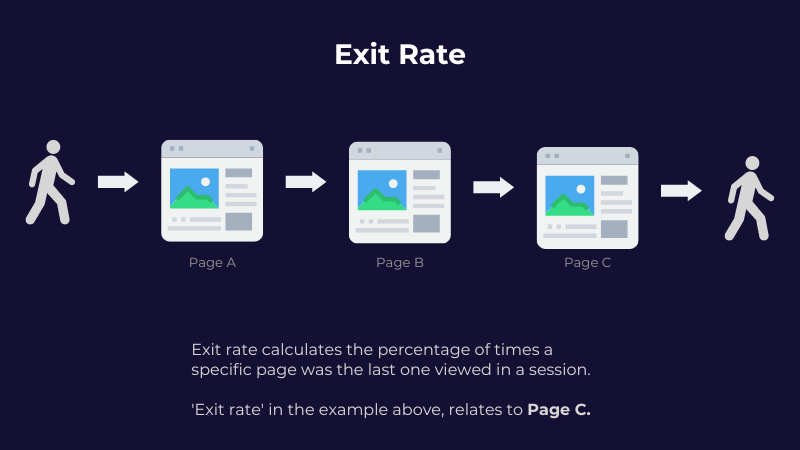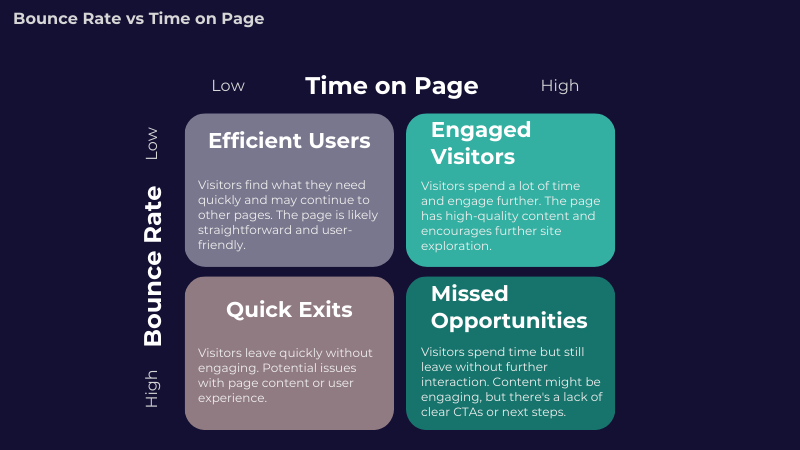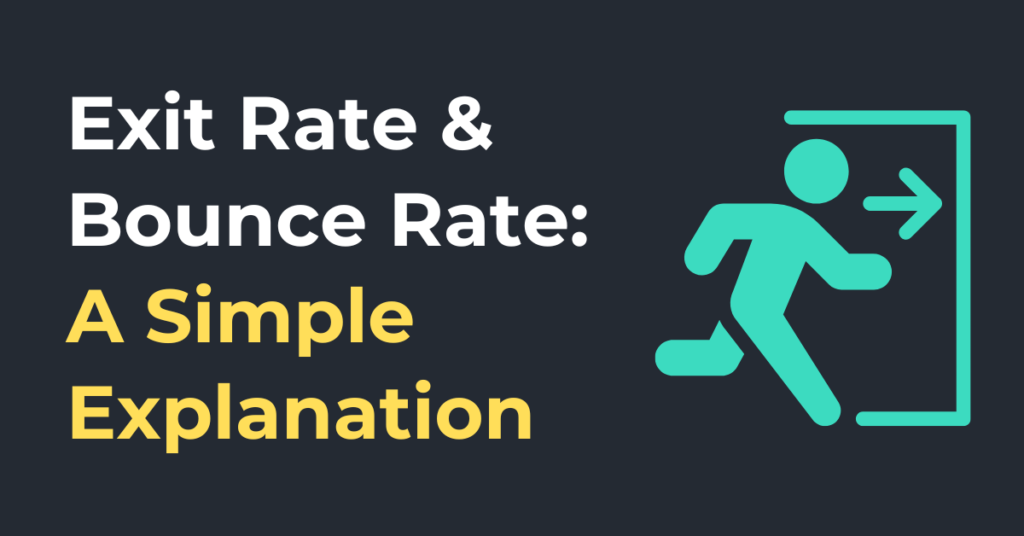Distinguishing between ‘exit rate’ and ‘bounce rate’ can feel like splitting hairs, but each metric offers unique insights into user behavior. While they might seem similar, they serve distinct roles in website analytics. Dive into our comprehensive guide on ‘exit rate vs bounce rate’ to elevate your site’s performance and user experience.
Why analysis is important
Understanding website metrics is crucial for any online business.
It’s not just about tracking visitors.
It’s about understanding their behavior.
By analyzing these metrics, you can make informed decisions.
For instance, you can optimize your website for better user experience.
Or, you can identify areas that need improvement.
One common confusion is between “exit rate” and “bounce rate”.
But, what do these terms mean?
And why are they so important?
Defining the Terms

What is Bounce Rate?
Bounce rate is a metric that tells you how many visitors leave after viewing just one page.
It’s a reflection of user engagement.
A high bounce rate might indicate that your landing page isn’t relevant.
Or, it could mean that the page didn’t meet the user’s expectations.
Understanding this can help you tweak your content.
For more on optimizing your website, check out this complete guide.
What is Exit Rate?

Exit rate, on the other hand, measures how often users leave from a particular page.
It doesn’t matter if they’ve viewed other pages before.
This metric is crucial for understanding user flow.
For example, if a product page has a high exit rate, it might need improvements.
Maybe the call-to-action isn’t clear.
Or perhaps the page loads too slowly.
By understanding exit rate, you can enhance user retention.
If you’re looking to improve your website, consider our website creation services.
Key Differences Between Exit Rate and Bounce Rate

How They’re Calculated
Bounce rate is calculated by taking the number of single-page sessions and dividing it by the total sessions.
It represents the percentage of visitors who enter and then leave without interacting further.
On the other hand, exit rate is about the frequency a page is the last in a session.
To calculate it, you take the number of exits from a page and divide it by the total views of that page.
This gives you an idea of how often users leave after visiting that specific page.
For a more comprehensive understanding of these metrics, the Understanding metrics in Google Analytics guide is a great resource.
Context in Which Each Metric is Used
Bounce rate is often used to gauge a page’s first impression.
If it’s high, it might mean the content isn’t resonating with visitors.
Or perhaps the design is off-putting.

For deeper insights into bounce rate, the Deep dive into bounce rate insights on SEMrush Blog is invaluable.
Exit rate, conversely, is more about the user’s journey.
It helps identify if a particular page is where users typically drop off.
Maybe the content is too dense, or there’s a technical issue.
Or it could simply be the natural end of their browsing session.
For a broader perspective on tracking user engagement, HubSpot’s Website engagement metrics to track is a must-read.
Understanding the Metrics in Google Analytics
How Google Analytics Tracks and Presents These Metrics
Google Analytics is a powerful tool for understanding user behavior.
It can aid us in massively when decoding our exit rate vs bounce rate data.
It tracks bounce rate by monitoring single-page sessions.
This means if a user visits a page and doesn’t interact further, it’s considered a bounce.
For exit rate, Google Analytics looks at the last page a user visits during a session.
It then calculates the percentage of times that page was the exit point.
Both metrics are presented in the Behavior section of Google Analytics.
This allows website owners to quickly assess page performance.
Common Misconceptions and Pitfalls
Many believe that a high bounce rate is always bad.
But that’s not necessarily true.
For instance, a contact page might naturally have a high bounce rate.
Users find the info they need and then leave.
Another misconception is that exit rate is just another term for bounce rate.
But as we’ve seen, they measure different things.
It’s essential to understand these nuances to make informed decisions.
Misinterpreting these metrics can lead to misguided optimization efforts.
Factors Influencing High Bounce Rates

Reasons Visitors Might Leave a Website Quickly
Several factors can lead to a high bounce rate.
Slow page load times are a common culprit.
Users today expect instant gratification.
If a page takes too long to load, they’ll likely leave.
Misleading meta descriptions or titles can also be to blame.
If users don’t find what they expect, they’ll bounce.
The Impact of Website Design, Content Quality, and User Experience
Website design plays a significant role in user retention.
Knowing this, can let you turn the exit rate vs bounce rate conundrum into a strategic plan!
A cluttered or outdated design can turn visitors away.
Content quality is equally crucial.
If the content doesn’t provide value or answer user queries, they won’t stay.
Lastly, user experience encompasses both design and content.
A site that’s hard to navigate or isn’t mobile-friendly will see higher bounce rates.
Always prioritize the user’s needs and expectations for better engagement.
Analyzing Exit Pages and Their Significance
How Exit Pages Can Indicate User Behavior
Exit pages provide a window into the user’s journey.
When a user leaves from a specific page, it tells a story.
Maybe they found what they were looking for and left satisfied.
Or perhaps they became frustrated and gave up.
By analyzing exit pages, you can identify potential issues.
It could be content gaps, technical glitches, or design flaws.
The Importance of Tracking Top Exit Pages for Organic Traffic
Organic traffic is a significant indicator of website health.
If your top exit pages align with high organic traffic, take note.
It might mean that searchers aren’t finding what they expected.
Or that competitors offer a better user experience.
By tracking these pages, you can refine your SEO and content strategy.
Strategies to Improve Bounce and Exit Rates
Tips and Best Practices
Tackling your exit rate vs bounce rate starts with understanding your audience.
Offer valuable, relevant content that meets their needs.
Ensure your website design is modern and user-friendly.
Optimize page load times and eliminate technical issues.
And always have a clear call-to-action to guide users.
Importance of A/B Testing and User Feedback
A/B testing lets you compare two versions of a page.
It’s a way to determine which elements resonate with users.
User feedback, on the other hand, provides direct insights.
By listening to your audience, you can make targeted improvements.
Industry Standards and Benchmarks
Different websites have varying benchmarks.
For retail sites, a bounce rate of 20-40% is considered good.
Landing pages, given their specific purpose, might see rates of 70-90%.
Portals, being content-heavy, often have a rate between 10-30%.
Understanding these standards helps set realistic goals and strategies.
FAQs
Which is more important bounce rate or exit rate?
Bounce rate and exit rate serve different purposes in analytics. Bounce rate measures the percentage of visitors who leave after viewing only one page, indicating the first impression’s effectiveness. Exit rate, on the other hand, shows the percentage of exits from a specific page, regardless of how many pages were viewed before. Depending on your goals, one might be more relevant than the other. For overall website health, both metrics are essential.
What is the difference between exit and bounce rate in Google?
In Google Analytics, bounce rate represents the percentage of sessions where users viewed only one page and then left without any interaction. Exit rate, conversely, measures the frequency a specific page is the last one viewed in a session. While bounce rate focuses on session initiation, exit rate emphasizes the end of user journeys.
What is meant by exit rate?
Exit rate is a metric that calculates the percentage of times a specific page was the last one viewed in a session. It provides insights into where users typically conclude their visits, helping website owners identify potential areas for improvement.
What is the exit rate in marketing?
In marketing, the exit rate is used to understand at which point users leave a website during their browsing session. A high exit rate on a particular page might indicate issues with content, design, or user experience, signaling areas that might benefit from optimization.
How do you calculate exit rate?
Exit rate is calculated by taking the number of exits from a specific page and dividing it by the total views of that page. The formula is: Exit Rate = (Number of Exits from a Page / Total Views of that Page) * 100%.
What’s a good exit rate?
A “good” exit rate varies depending on the type of page and its purpose. For instance, a contact or thank you page might naturally have a high exit rate, as users complete their intended action and leave. However, a high exit rate on a product or content page might indicate areas for improvement.
Is high exit rate good or bad?
A high exit rate can be either good or bad, depending on the context. For pages meant to conclude user sessions, like a checkout or contact page, a high exit rate is expected. However, for other pages, a high exit rate might indicate issues that need addressing.
Is a high exit rate bad?
Not necessarily. While a high exit rate on certain pages might indicate problems, on others, it might be entirely expected. It’s essential to analyze the context and purpose of each page before drawing conclusions.


